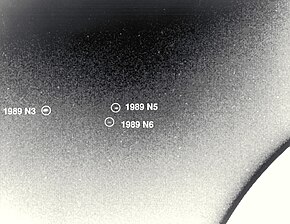 Thalassa (1989 N5) seen by Voyager 2 on 23 August 1989 | |
| Discovery | |
|---|---|
| Discovered by | Richard J. Terrile[1] and Voyager Imaging Team |
| Discovery date | September 1989 |
| Designations | |
Designation | Neptune IV |
| Pronunciation | /θəˈlæsə/[2] |
Named after | Θάλασσα Thalassa |
| Adjectives | Thalassian /θəˈlæsiən/[3] |
| Orbital characteristics[4][5] | |
| Epoch 18 August 1989 | |
| 50074.44 km | |
| Eccentricity | 0.00176±0.00054 |
| 0.31148444±0.00000006 d | |
| Inclination |
|
| Satellite of | Neptune |
| Physical characteristics | |
| Dimensions | (108±6) × (100±12) × (52±6) km[6] |
| 41±3 km[6] | |
| Mass | ~3.54×1017 kg (calculated) |
Mean density | 1.23±0.43 g/cm3[7] |
| synchronous | |
| zero | |
| Albedo | 0.091[6][8] |
| Temperature | ~51 K mean (estimate) |
| 23.32[8] | |
Thalassa /θəˈlæsə/, also known as Neptune IV, is the second-innermost satellite of Neptune. Thalassa was named after sea goddess Thalassa, a daughter of Aether and Hemera from Greek mythology. "Thalassa" is also the Greek word for "sea".
- ^ Cite error: The named reference
Willman-Neptunewas invoked but never defined (see the help page). - ^ "thalassal". Oxford English Dictionary (Online ed.). Oxford University Press. (Subscription or participating institution membership required.)
- ^ The complete poetical works of Robert Browning (1912)
- ^ Cite error: The named reference
Jacobson2004was invoked but never defined (see the help page). - ^ Cite error: The named reference
Showalter2019was invoked but never defined (see the help page). - ^ a b c Cite error: The named reference
Karkoschka2003was invoked but never defined (see the help page). - ^ Cite error: The named reference
Brozovic2019was invoked but never defined (see the help page). - ^ a b Cite error: The named reference
jplssdwas invoked but never defined (see the help page).